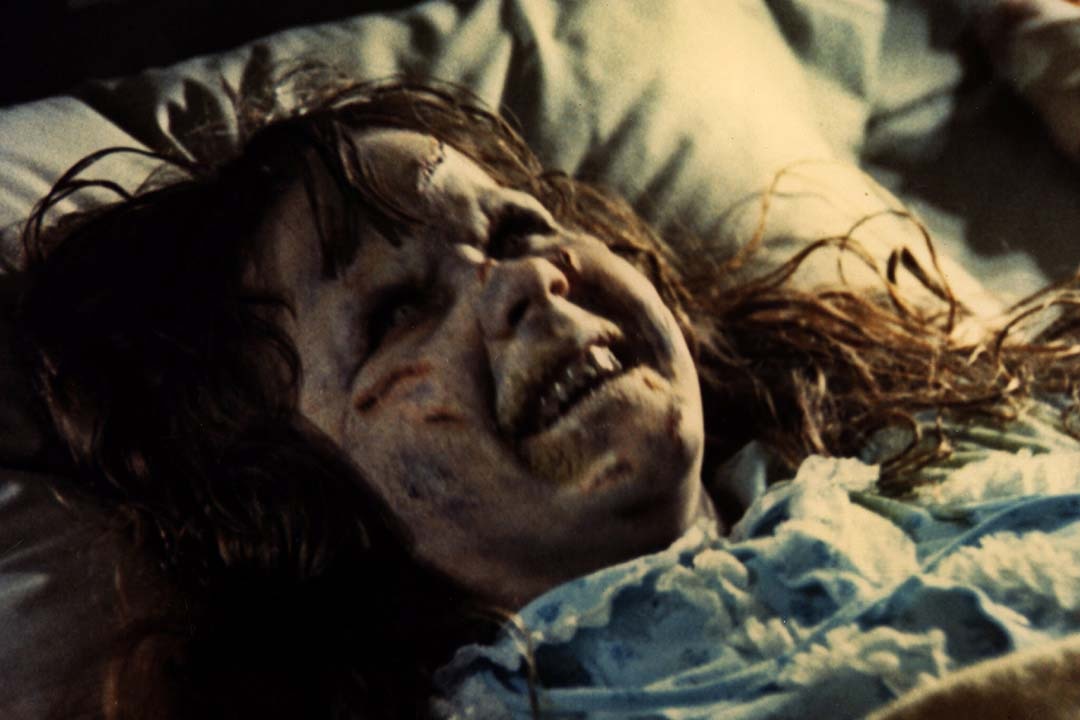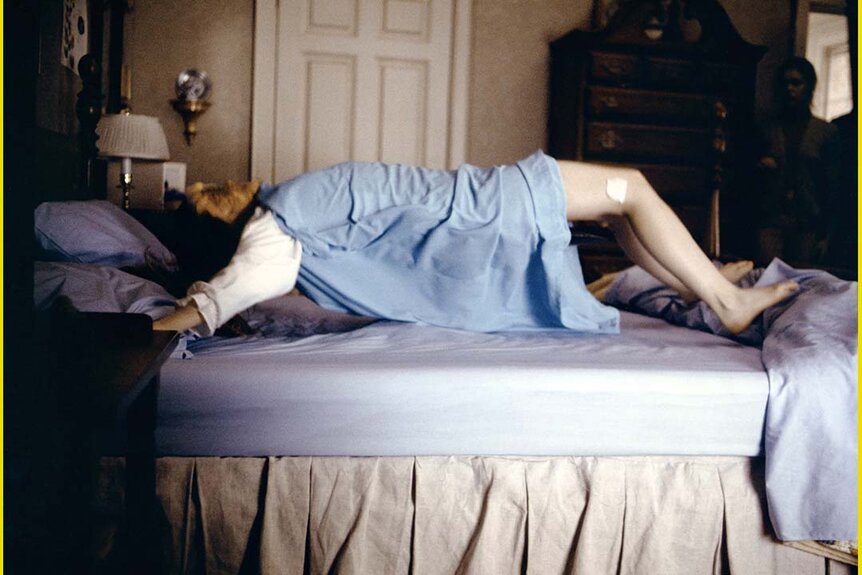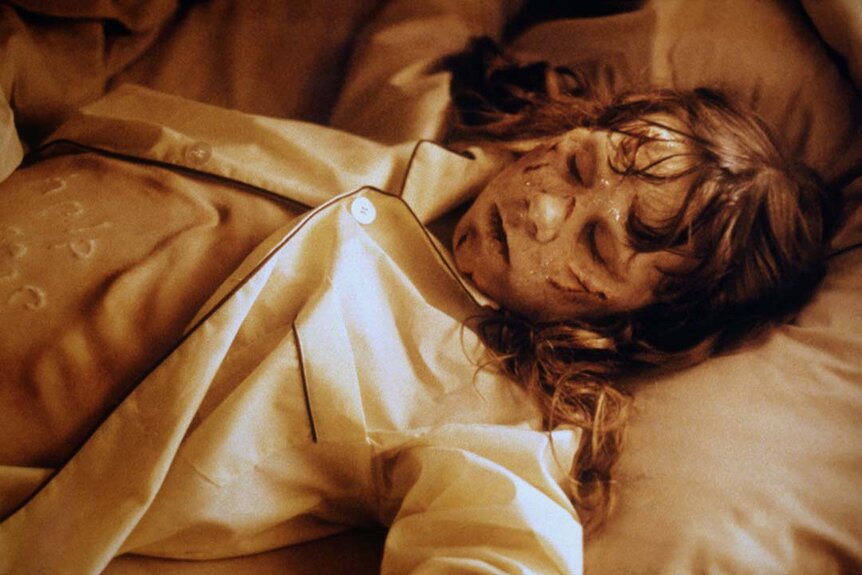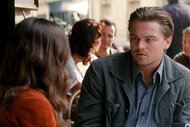Create a free profile to get unlimited access to exclusive videos, sweepstakes, and more!
Why The Exorcist Still Haunts Us, 50 Years Later
William Friedkin's legendary film is about so much more than the Devil.

Being a horror fan means constantly hearing from friends and acquaintances that horror movies aren't actually scary.
I'm not sure where this phenomenon started, or how, but it happens to me more times in a year than I'd care to count. Someone brings up scary movies, and then someone else has to start talking about why they don't like horror, and They're not actually scary always somehow comes up. It's fine if you're not scared by horror films, of course, but I find this phenomenon increases exponentially when the horror story in question is particularly well-regarded. Which is how I came to hear one particular tidbit that stuck with me in ways other boasts just didn't.
"I don't find The Exorcist scary, because I don't believe in demons."
Again, there's nothing inherently wrong with this. It doesn't make you a bad person to dislike The Exorcist, or to reject horror films outright because that's just not how you're wired. But something about this statement, which you'll encounter more than a few times if you're willing to go looking for people who feel this way, nagged at me. Then I revisited William Friedkin's classic film, which turns 50 this year, and I realized why: It's a statement that misses the point of The Exorcist entirely.
RELATED: Linda Blair Pays Tribute to Exorcist Director William Friedkin
Yes, demons are central to the plot of the film, based on the novel of the same name by William Peter Blatty and often billed as the "scariest movie ever made." The catalyst for the entire story is the demonic possession of a young girl named Regan (Linda Blair), whose only crime seems to be getting lonely and playing with a Ouija board she found in the basement of the Georgetown home she shares with her mother, Chris (Ellen Burstyn). The film's climax is a dramatic exorcism in the classic Roman Catholic sense, complete with repeated prayers, holy water, and commands brimming with Christian conviction. The film was so successful, both commercially and critically, that it inspired a whole subgenre of demonic possession films that persists even today, so it makes sense that the demon of it all would be the thing our collective imagination would latch onto and hold in our minds forever.
But that's not all there is to the film. If there were, it wouldn't be the scariest movie ever made, a film we still can't stop talking about, a film that haunts us after five decades.
As we prepare for The Exorcist story to continue with Universal's The Exorcist: Believer, in theaters October 6, let's dive back into the film that started it all and why it still keeps us up at night.
Ordinary Horror
William Friedkin was smart enough to know that he couldn't make The Exorcist a straightforward, bare bones story of a girl with a demon living inside her, because he'd be left with nothing but a sensational display of visual effects. Make no mistake, the effects in The Exorcist still play spectacularly well, but the director was very aware that he needed to make you not just understand, but care about Regan in the lead-up to her all-out possession. So, much of the film's first hour unfolds like a domestic drama with occasional punctuations of the supernatural. Regan is an effervescent, if shy, girl who moves a lot because of her mother's job and misses her father, who's off living his own life in Europe. She's lonely, seems to only have adults to spend time with, and loses herself in little art projects and flights of imagination. She feels, Friedkin shows us, the pain of her parents' separation, but she does her best to have a good time, to enjoy the privileges of her life as the daughter of a rich and famous actress.
But something is still wrong with Regan, something hidden, something simmering below the surface of her easy smile and kind eyes.
Friedkin presents this strange descent into darkness with remarkable restraint, at least at first, showing us Regan dazedly urinating on the carpet in the family home, wincing and moaning through a battery of medical tests (which, anecdotally, proved more upsetting for some theatrical audiences than the exorcism scenes), behaving strangely with a sense of pain and confusion behind her eyes. It's something anyone who's a parent, or anyone who's been close to someone going through a dark time physically or psychologically, can feel in their bones. Regan's mother spends every waking hour searching for an answer, while Regan herself falls deeper into a very ordinary kind of despair, the sense of being pulled along by currents she doesn't understand, knowing at any second she could go under. It's heartbreaking, it's relatable, and most of all, it's horrifying, because we can feel it happening even without the voice of a demon chiming in.
The Art of Evil
So you've got a little girl, suffering for no good reason, a mother losing her mind over her daughter's pain, and a big old house that seems to be closing in on them with each passing second. That's already a recipe for a solid piece of horror filmmaking, but then comes the attention to detail that imbues the whole story with a greater sense not just of darkness, but of meaning.
Friedkin and his cinematographer, Owen Roizman, shot The Exorcist as a study in contrast. Regan and Chris' home in Georgetown is warm, comfortable, and inviting, from the sunlit kitchen to the cozy piano room...right up until the moment it isn't. We see the domestic possibilities of this house, the comfort it can offer, and then it becomes a prison, a cold oubliette for a mother and her daughter to hide from the world, desperate for help. Regan's bedroom becomes a padded cell, suffused with dim white light far removed from the more amber-colored hues of the house when things were better. The cold seeps in, not just in the way the characters breathe, but in the way the home is sapped of its sense of joy. That's all thanks to the extraordinary visual dynamism at work, and that's before you get to Dick Smith's incredible makeup effects.
But the look of the film isn't the whole story either. The Exorcist won two Oscars at the end of its run, one for Blatty's adapted screenplay, and one for Best Sound. Both awards are deserved, but the film's soundscapes -- designed and implemented by a team led by Robert Knudson and Chris Newman -- are arguably the most impressive thing about it all these years later. From subtle whispers in the background to all-out pandemonium as a chorus of demonic voices envelop the theater, the sense that you're being constantly pursued by otherworldly voices is palpable and relentless in The Exorcist. It's perhaps the greatest sound design achievement in horror history, and it's the best example of the way the film layers in its terror to create something claustrophobic and inescapable...at least until the exorcists come in.
Human Sacrifice
We've talked already about how Regan's suffering works as a relatable point of horror even without the demon directly appearing before us as an audience, but of course the demon does show up eventually. For the film's final act, Regan is completely encased in its evil influence, trapped in a ragged version of her own body, speaking with a guttural voice, defying physics and human anatomy with her contortions. These scenes, in which a pair of exorcists -- played by Jason Miller and Max von Sydow -- turn up to try and drive the demon out of Regan, are the most famous in the film, but they tell a larger story than the rite of exorcism itself.
For much of the film, while we've been tracking Regan and Chris descending into darkness, we've also been following the exorcist of the title, Damien Karras (Miller). A priest who's also a psychologist, Karras walks in two worlds, science and faith, and his journeys through a decaying world have begun to weigh on his mind. Karras' faith is waning, impacted by the loss of his late mother, his sense of guilt over never being able to do enough, and a lack of fulfillment in his work. He feels adrift, lost, hanging by a thread to the church to which he devoted his life. He's angry, and bitter, and spends much of the film convinced that Regan isn't actually possessed, but another manifestation of psychological pain, both for her and for himself.
Which brings us to what makes The Exorcist so effective and impactful even if you're a demonic-skeptic. In the film's final minutes, the rite of exorcism actually fails. Father Merrin (Von Sydow) warns Karras that the demon will attack him psychologically, try to get into his head and shake his faith. And guess what? It works. Merrin dies of a heart attack while trying to battle the demon alone, and Karras comes back in the room to find his colleague dead and the demon celebrating another victory. There is no magic answer, no ritual that can stop this kind of senseless, pervasive evil, so Karras summons the old prizefighter he once was, the battered fighter who doesn't understand the world anymore, and uses his fists instead of his faith. He batters the demon and demands he become the new vessel, and the demon, against all odds, agrees, perhaps because it wants to punish this stubborn man who no longer wants to operate within the bounds of the priesthood. The demon takes Karras, Karras hurls his body out a window, and Regan is saved.
In a film that's so tied up in matters of faith, and God, and Satan as the source of ultimate evil, The Exorcist's ending strikes a deeply humanist, bittersweet note. The operatic nature of the battle between good and evil falls away, and it becomes a story of a young girl in trouble, and the adults who gave their lives to help her. Karras doesn't attack the demon out of a sense of faith, but out of a sense of right completely detached from his belief in God. He simply wants it to be over, wants this girl to stop suffering, want this monster to go away. With this ending, after all the horror that's come before it, Friedkin presents a film that tells us that evil can pop up anywhere, and if we want to fight it, all we have is each other.
The Exorcist saga continues with The Exorcist: Believer, in theaters Oct. 6. Get tickets at Fandango.
Stream more films in the saga with The Exorcist III and Dominion: Prequel to the Exorcist, now streaming on Peacock.




























